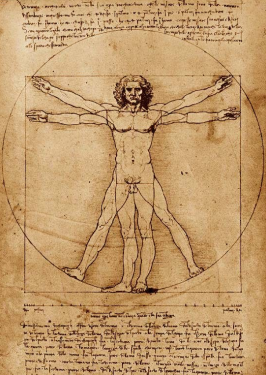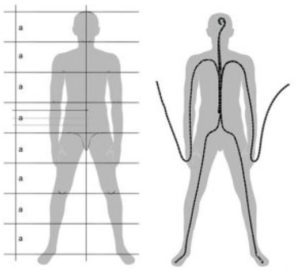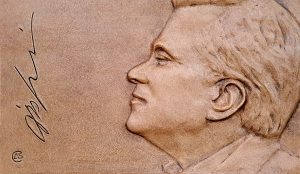Proportions of the human body by Alexander Cherkov, from the book "Introduction to the World of Art"Sculpture, painting, drawing and more"
Humans are different from each other. It is difficult to say which proportions are considered correct, and whether such proportions are always desirable. From the history of art it can be seen how the violation of the rules of proportion in some artists led to the attainment of a higher expression of the figure. We will proceed from the premise that knowledge of minimal principles in the structure of human body proportions will be helpful in achieving greater reliability for our creations and greater confidence in the truths of our perception.
Many artists take approxbase For the establishment of human body proportions the The size of the head (Without the cover or hair of the head, only the distance between the chin and the apex of the head). In my experience this is a very convenient and effective way also to properly express a person’s age.
A person is born, and up to a year or so, maintains a 1: 4 ratio between head size and height. Then, the head grows more slowly than the body, and thus, the ratio of head size to total height begins to gradually decrease, reaching a ratio of 1: 8 in adulthood. At the same time, people below the average height (which varies from period to period) may remain in the adolescent ratio, i.e. around 1: 7 - 1: 7.5. Whereas people above average height reach a ratio of 1: 8.5 and even 1: 9, if their height is 2 meters or more.
At the end of the fertile age, a person's growth may begin to decline and the ratio of head to height may vary from 1: 7 - 1: 7.5.
Another aspect of age-changing proportions has to do with the difference in body composition of women and men. In childhood, about up to 8-9 years, the differences in the proportions of childhood and adolescence are almost indistinguishable. Everyone has shoulders wider than the waist, and the abdomen is more massive than the hips and chest. Also in the profile, it is evident that the head is the widest place (remember, in childhood we noticed that if the head passes the opening of the fence, then the body of the child will also pass).



With the onset of the development of secondary sexual characteristics in children, that is, with the onset of adolescence (in different children at different times), the proportions increasingly express the feminine or masculine principle of man. In boys, the upper part of the torso develops and grows - the shoulder girdle and chest. In girls, the lower part of the torso develops, i.e. the thigh area. For them, the width of the thighs is equal to the width of the shoulders.

All of the above will help more precisely capture the uniqueness of the proportions in children, depending on age and gender.
In late adolescence and throughout life, the human body acquires a more prominent feminine or masculine shape, characterized by the shape of a symbol by a triangle with a summit facing up or down. In the child, remember, the proportions of the upper body are not clearly expressed.

Proportions in adult human body structure
Proportion of a person in old age in a ratio of 1: 8 between the human head and his total height, is perceived as very aesthetic and convenient for the construction of various positions, as it allows to easily determine the points of flexion of the joints.

The size of an adult's feet (a) is approximately equal to the size of the head.

An adult's palm size is about 4/3 of the head size.

Comments on the proportions of the human body
It is always worth remembering that people with different physical structure and ages can be significantly different from the ideal proportions. For example, people in old age or athletes with larger-than-average body dimensions.


And another thing, the level of fat in the human body does not affect the determination of proportions.

Exercises and tips on the proportions of the human body
Recommended registry products
-
- out of stock
Registration kit for children
- ₪162
- Read more
-














